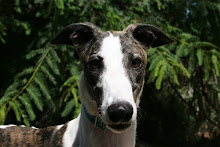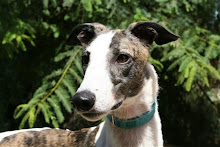

.jpg)


Top to bottom: Daphne, Zephyr, Portia, Bingley and Magic
The dog attack in Emerald Heights serves as another reminder that the entire body of laws and their enforcement in San Diego County need to be re-examined and reformulated to fit the current situation which includes:
1. Much denser population than existed when current laws and policies were made.
2. A rise in two career families, leading to dogs being left on their own for long stretches of time.
3. Severe dog overpopulation.
4. No-kill shelters (good), leading to re-homing of rescued dogs with "issues". (Good, but challenging).
This is probably not a complete list of changes that have occurred regarding dogs and people, but these are all factors contributing to the current problem of unsocialized, unrestrained dogs on North County streets and parks who present threats to the safety and lives of people and leashed dogs.
Since April, 2001, five rescued dogs have been a part of my life. Two of the five are currently members of my household. John and I would not have wanted to miss knowing any of them. However. Each one of them came to us with their own quirks and issues that were their individual adjustments to their genetic predispositions and their unique--sometimes cruel--life experiences.
We have not brought one of these dogs into our home that did not make me initially ask myself: "What have I done? Am I really able to meet the challenges that this dog presents?"
Sometimes it has taken weeks. Sometimes it has taken months. But, eventually, we form our methods of two way communication. The dog learns that John and I can be trusted for basic needs, acceptance and love. A new equilibrium is established in our household, and we watch our new doggie begin to share their "true selves" with us.
However: Each one of these dogs has enduring traits that are reflections of their previous life.
Daphne never could overcome her terror of motorcycles and loud trucks. Nor could she learn to modify her aggressive reaction to them. The puppy abandoned and alone on the streets of L.A. was a permanent part of her make up.
Zephyr never was able to overcome her fear of anything that sounded like a gunshot. Whenever she heard an engine backfire, she turned and ran for home. We suspect that during her long racing career, she witnessed the shooting of her less successful competitors.
Portia had night terrors. She was apparently re-living some early trauma--perhaps the race when she broke her ankle.
Bingley is very high prey. A model citizen in the home, he becomes The Mighty Hunter once we hook up collar, harness and leashes and open the door. We are resigned to his never being able to unlearn the early training that his job, indeed his life, depended on his being able to chase down fuzzy creatures.
Magic is still settling in. But the years of confinement in a cage, having no nurturing contact with a human have clearly made her anxious in new situations. Unsure of her safety, she is poised to bolt.
Now. Think about it. Do these dogs deserve a chance to live out their lives in a loving home? I think they do. Do these dogs deserve to enjoy daily walks on a leash? I think they do.
I work with my dogs. I teach them "no", "let's go", "down". But I am not sanguine about being able to overcome early learning and trauma. I depend on collars, leashes and harnesses to enable me to restrain them from being nuisances or even menaces to other dogs.
I also depend on other dog owners to keep their dogs restrained. Their dogs might be models of canine good citizens. But all dogs are unpredictable. Even highly trained dogs. I do not take my dogs into situations that I have reason to believe are beyond their tolerance. I rely on other dog owners to obey the laws so that my dogs can live a reasonable doggie life.
Rethinking dog-human laws and their enforcement is necessary at this time for many reasons. But an important reason is that people are becoming more and more aware of the challenges of homeless dogs and are adopting rescued dogs. This is a Really Good Thing. But it makes realistic dog related laws and enforcement all the more critical.


.jpg)
.jpg)
.jpg)
